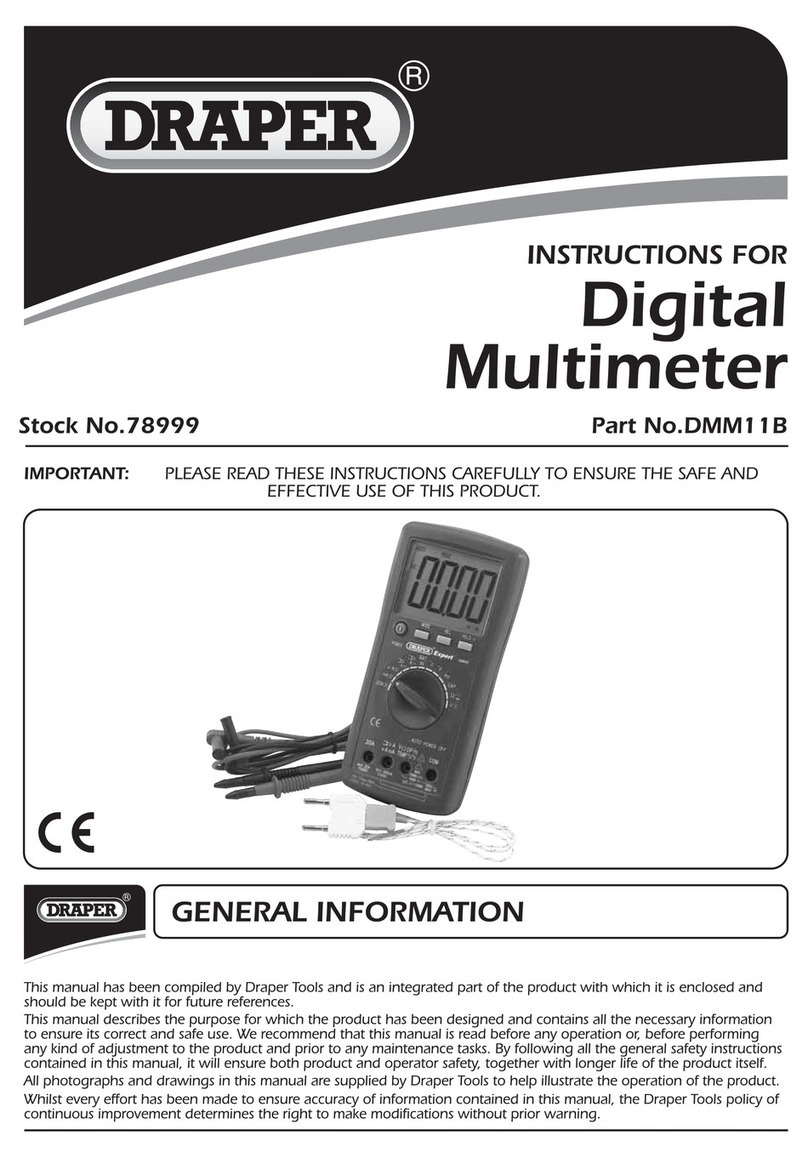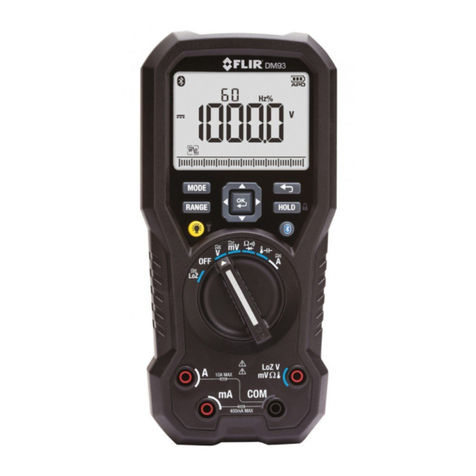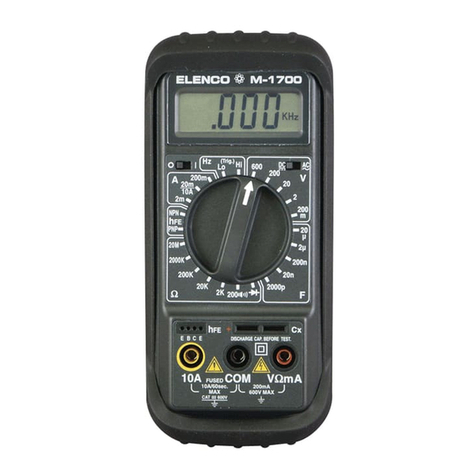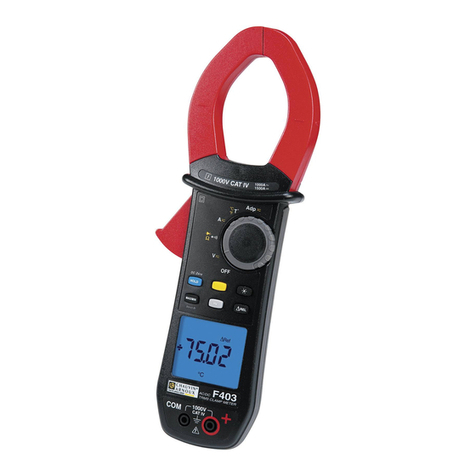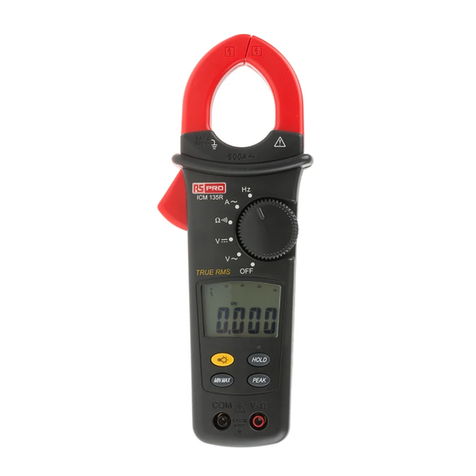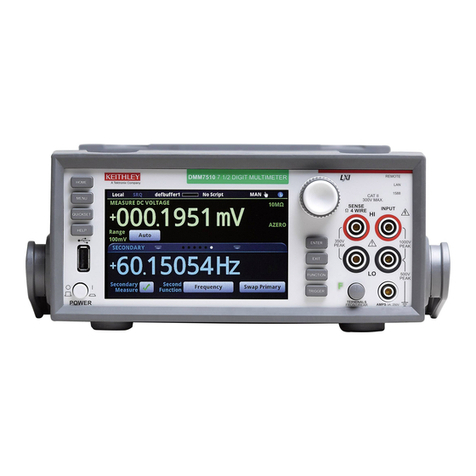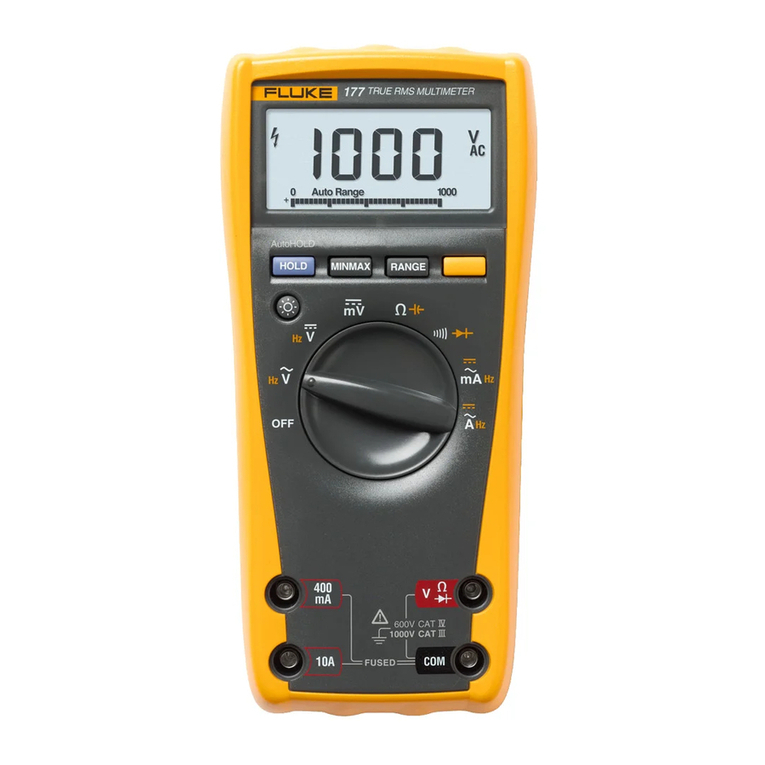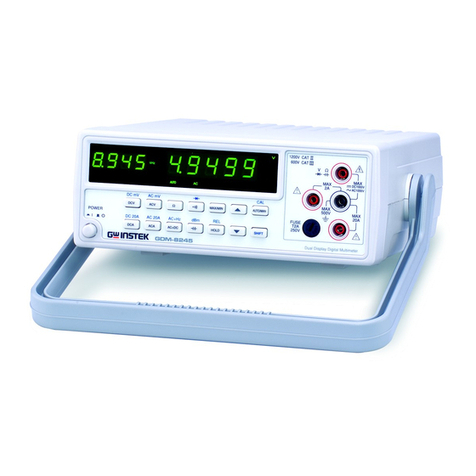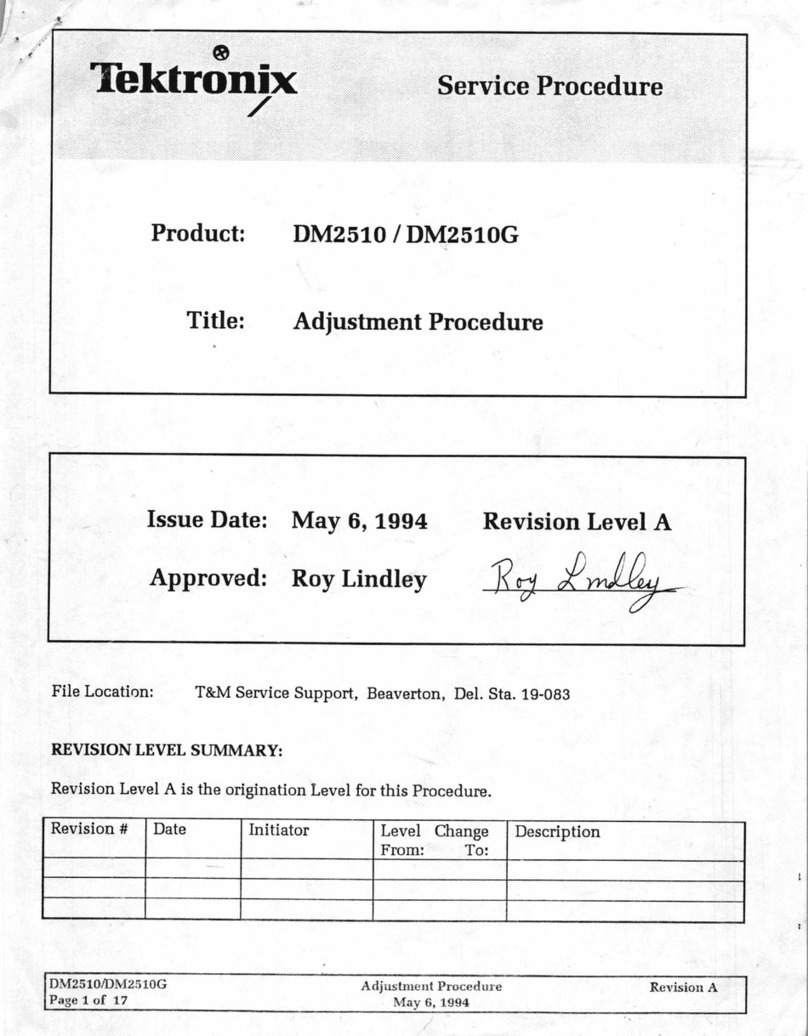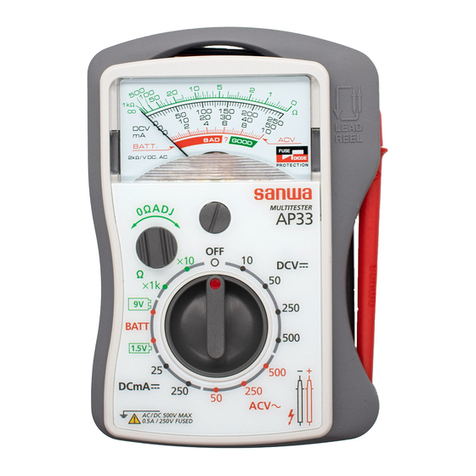lnnova 10 MegOhms User manual

DIGITAL
c<·~·>~
MULTIMETER
10
MegOhms
ER'S
UAL
c@us

Title Page No.
INTRODUCTION
..................................
1
SAFETY PRECAUTIONS/WARNINGS
.................
1
SPECIFICATIONS
................................
3
CONTROLS AND INDICATORS
......................
6
TESTING PROCEDURES
..........................
7
BATTERY AND FUSE REPLACEMENT
...............
11
MAINTENANCE
.................................
11
SERVICE PROCEDURES
.........................
12
INTRODUCTION
• Congratulations.
You
have purchased a precision instrument
manufactured to the highest quality standards. This Digital
Multimeter is a general-purpose instrument designed for use
in
general electronics, home electrical applications, and auto-
motive electrical/electronic systems.
• This meter is designed to
test
or
measure
AC voltage, DC
voltage, batteries, DC current, AC current, resistance, diodes
and continuity.
• Please take the time to read these operating instructions thor-
oughly
and·
completely. Failure to follow these instructions may
result
in
electrical shock, instrument damage and/or damage
to the equipment under test. Always use extreme caution
when working on or around electrically operated equipment.
SAFETY PRECAUTIONS/A WARNINGS
1
Do
not
operate this multimeter before reading this manual in its
entirety. The following guidelines must be followed to avoid acci-
dents that can result
in
electric shock or personal injury.
• Pay close attention to A WARNINGS stamped on the front
and rear
of
the meter's case. These warnings, as well as all
warnings and precautions used through out this manual, must
be followed to avoid electric shock and/or personal injury.
• The RESPONSIBLE PARTY shall be made aware that,
if
the
equipment is used
in
a manner not specified by the manu-
facturer, the protection provided by,
the equipment may be
impaired.
• Before using any
of
the functions on this meter, verify its
·proper operation on a known similar function source where
the unit value is also known.
Take
corrective action based on
the indicated results.
To
prevent electri.cal shock and/or damage to the tester or the
equipment under test, observe the following safety precautions:

• DO NOT.apply more than the rated voltage, as marked
on
the meter, between terminals or between any terminal and
earth ground.
• Use caution when working above 30V
AC
rms, 42 V peak, or
60 V
DC.
Such voltages pose a shock hazard.
•
·To
avoid false readings that could lead to possible electric
shock or personal injury, replace the batteries as soon as the
low battery indicator
_.
displays.
• Always inspect the multimeter, test leads and any other
accessories for damage prior to every use. If any damage is
found, do not.use tester until repairs are done.
• Always consider electrical and electronic equipment to
be
ener-
gized (live). Never assume any equipment
is
de-energized.
• Never ground yourself when taking electrical measurements.
Isolate yourself from ground by using dry rubber insulating
mats to cover all exposed/grounded metal. Stand
on
rubber
mats
and
wear dry clothing.
• Never take resistance measurements on energized (live)
electrical or electronic equipment.
• Use one hand, instead of
two,
whenever possible to take
measurements. Iftwo hands must be used, use extreme cau-
tion not to contact any energized conductors with your hands.
Be certain test leads are dry and clean.
•
Do
not hold the instrument when taking measurements. Place
the instrument on a clean, insulating surface prior to taking
any measurement.
• Don't become part
of
the circuit. Think safety. Act safely.
Ifworking on a vehicle, take the following added precautions:
• Only work on vehicle
in
a well ventilated area.
• Always wear safety eye protection.
• Avoid moving fan blades
or
any potentially moving parts.
• Avoid hot engine parts.
• Put transmission
in
"park" (automatic transmission vehicles) or
"neutral" (manual transmission vehicles). Set the parking
brake.
•
Turn
the ignition "otr' before connecting or disconnecting any
testing equipment.
• Put blocks on drive wheels.
• Avoid wearing loose clothing or jewelry when working on a
vehicle.
• Read your vehicle's service manual and follow it's safety pro-
cedures.
2

SPECIFICATIONS
GENERAL SPECIFICATIONS
AND
FEATURES
• 3-% digit LCD display (maximum reading
of
2000); 3 LEOs;
green, yellow and red
• Auto Range (ACV,
DCV,
Ohm, AC rnA, and DC rnA)
• Automatic negative (-) polarity indication
• Automatic zero adjustment
• Over range indicator (except 10 A function). Displays "OL" on
LCD
• Low battery indicator. Displays battery symbol
..
on LCD
• Automatic
powe~
shut off(after 15 idle minutes)
• Pollution Degree 2
• Measuring circuit category
II
• Operating environment:
Temperature -32° to 104o
F.
(0° C to
40o.
C)
Humidity-
Less than
80°/c;
relative humidity (non-condensing)
Altitude-
up to 6562 ft (2000 meters)
• Storage environment:
Temperature -4oto 140° F (- 20° to 60° C)
Humidity- Less than
90o/o
relative humidity (non-condensing)
• Power Supply:
Two
1.5V
AA
batteries
• Fuse: 315mA/250V 5X20 mm (Radio Shack, GMA/217
series; #270-1046) fuse ·
• Dimensions:
Height-
5.50 in. (139 mm)
Width -3.50 in. (89 mm)
Depth -1.25 in. (32 mm)
• Weight (including batteries): approximately 6.3 oz (180 g)
ELECTRICAL SPECIFICATIONS
DC VOLTS
Range Resolution
Accuracy
Notes
200.0mV 0.1mV
2.000V 1mV
±(0.8o/o
of
Input Resistance: 1
OMQ
20.00V 10mV reading Overload Protection: 600V DC
200.0V 100mV + 5 digits)
or
AC 600V RMS.
600V 1V
3

ACVOLTS
Range Resolution
Accuracy
Notes
2.000V 1mV Input Resistance: 10MO
20.00V 10mV ±(1.2°/o
of
Overload Protection: 600V DC
200.0V 100mV reading
or
AC 600V RMS.
600V 1V + 5 digits) Frequency Response:
50Hz-
400Hz
~ESISTANCE
(OHMS)
Range Resolution
Accuracy
Notes
200.00
100mo
2.000k0
10
±(1.0%
of
Overload Protection: 250V DC
20.00ko
100
reading
+ 5 digits) or AC RMS.
2oo.oko
1000
2.oooMo
1ko
20.00MQ 10kQ
±(2.0o/o
of
reading
+ 5 digits)
DC
AMPS
Range Resolution
Accuracy
Notes
20.00mA 1
OJ,LA
±(1.0°/o
of
Overload Protection: Fuse
reading 315mA/250V
200.0mA
100J.LA
+ 5 digits) Input Voltage Drop: <0.2V.
2.000A 1mA
±(2.0o/o
of
Unfused; 15sec maximum
*10.00A reading Input Voltage Drop: <0.2V.
10mA + 5 digits)
*A waiting period
of
at least 15 minutes is necessary between
every 15 second testing period.
ACAMPS
Range Resolution
Accuracy
Notes
20.00mA
10JJA
±(1.5o/o
of
Overload Protection: Fuse
200.0mA
100J.LA
reading 315mA/250V
+ 5 digits) Input Voltage Drop: <0.2V.
4

BATTERYTEST (LEOs)
When the voltage
of
the
battery
being
tested
is
lower
than
10%
of
its
rated voltage, the·
red
LED
will
not
light.
Load
Range
Resolution
Current
Accuracy
Notes
Green LED: 1.30V
±0.075V and
up.
Yellow
LED: 0.94V
1.5V 0.001V 10mA ±0.075V to 1.29V
(approx.) ±0.075V.
Red LED:0.15V±0.075V
to 0.93V±0.075V
Green LED: 5.22V
±0.3V and
up.
Yellow
LED: .3.76V
6V 0.01V 100mA ±0.3V to 5.21V±0.3V.
(approx.) ±(5%
of
Red LED:0.6V±0.3V to
reading 3.75V±0.3V
+ 5 digits) Green LED: 7.83V
±0.45V and
up.
Yellow
LED: 5.64V
9V 0.01V 10mA ±0.45V to 7.82V±0.45V.
(approx.) Red LED:0.9V±0.45V to
5.63V±0.45V
Green LED: 10.44V
±0.6V and
up.
12V 0.01V 200mA
Yellow
LED: 7.52V
(approx.) ±0.6V
to
1
0.43V±0.6V.
Red LED:1.2V±0.6Vto
7.51V±0.6V
DIODE/CONTINUITYTESTS
Function
Range
Resolution
Description
Note
Diode Test 2V 1mV Test Current:
1±0.6mA
Test Voltage: Overload
Approx. 1.5V Protection:
Continuity
2000
0.10
Approx.
1200
or
250V DC
or
Test less, buzzer
ACRMS
(beeper) will
sound
5

CONTROLS AND INDICATORS
1. DCV Function: Measures
DC
volts. Auto-ranging from 0 to
600 volts (
1
0
Mn
impedance)
2.
ACV Function: Measures
AC
volts. Auto-ranging from 0 to
600 volts (10
Mil
-impedance)
3.
Resistance
Function:
Measures resistance. Auto-
ranging from 0 to
20Mn
(20,000,000Q).
4.
ACmA Function. Measures
AC
current in milliamps. One
range: 0 to 200 milliamps.
5.
DIODE
Function
..._ : For
testing diodes.
13
12
14
11
10
9 8 7
15
1
2
3
5
6
6.
CONTINUITY
Function
·>»
: Tests for continuity between
two points.
7.
Volts, mA, OHMS,
BAT,
DIODE and CONTINUITY
Input
Jack.
8.
COM
Input
Jack: Common·InputJack.
9.
DC10A
Input
Jack. For red test lead probe connection
when measuring high DC current (up to 10 amps only).
10. DC10A
Function:
Measures DC current. One range:
10Amps (DC from 0 to 10 amperes). Unfused.
11. DCmA Function: Measures DC current
in
Milliamps. One
range: 0 to 200 milliamps.
12. BatteryTest Function: Four ranges and three LEOS (green,
yellow and red). Tests small batteries;
1.5V,
6V,
9V and
12V.
13. OFF Function: Turns unit "off'' when function
is
selected.
14. Function/Range SelectorSwitch: Selects desired function
or range.
15. Liquid Crystal Display (LCD): Displays results of tests or
measurements.
Preparation and Caution Before Use
• Inspect the digital multimeter for damage to the case. Do not
use if cracked, distorted, excessively dirty or any abnormal
condition exists.
• Inspect the test leads for damage. Check for cracked insula-
tion, broken or damaged probes, loose or bent probe pins.
Do
not use ifany abnormal condition exists.
• Set the Function/Range Selector Switch to the proper range
BEFORE taking measurements. If the range/function must
6

be switched during a test, ALWAYS remove
t~e
test leads
from the circuit being measured before switching settings.
•
To
avoid possible electric shock, instrument damage, and/or
equipment damage when taking voltage
or
current measure-
ments, DO NOT exceed the maximum value
of
the selected
range.
• Ifthe unit is used near high noise Radio Frequency (RF) gen-
erating equipment (spark plug wires, ignition coils
or
alterna-
tor), the display may become unstable or indicate large errors.
Ifyou obtain erratic readings during use, isolate the Multimeter
as far away as possible from these components.
TESTING PROCEDURES
7
A. AC/DC VOLTAGE MEASUREMENT
A WARNING A
To
avoid
possible
electric
shock,
instrument
damage
and/or
equipment
damage, DO NOT
attempt
to
measure
voltages
ABOVE
600V AC/DC
or
take measurements
if
the voltage
is
unknown. 600V ACIDC between the COM
and
V
jacks
is
the
maximum
voltage
that
this
instrument
is
designed
to
measure. The
"COM"
terminal
potential
should
not
exceed 300VAC/DC
measured
to
ground.
1. Plug the BLACK test lead into "COM" jack
of
the multimeter;
plug the RED test lead into the "V" jack.
2. · Set the meter's Function/Range Selector Switch to the
appropriate ACV
or
DCV position as desired (see Controls
and Indicators, Items 1 and 2).
3. Place the RED test lead onto the positive (+) side
of
the item
being tested and the BLACK test lead onto the negative (-)
(across the source/load) side
of
the item. BE CAREFUL notto
touch any energized conductors with any part
of
your body.
4. Read the results on the display.
B. RESISTANCE MEASUREMENT n (OHMS)
A WARNING A
Resistance measurements
must
be made
on
"de-ener-
gized"
(dead)
circuits
ONLY.
Impressing
a voltage
across
the
multimeter's
terminals while
set
to
any
resistance
range
may
result
in
electric
shock,
instrument
damage
and/or
damage
to
equipment
under
test.
MAKE
SURE
equipment
is
completely
de-energized before
taking
any
resistance measurements.

1. Plug the RED test lead into the
"0"
jack
of
the multimeter;
plug the BLACK test lead into the "COM" jack.
2. Set the meter's Function/Range Selector Switch to the
"0"
range function (see Controls and Indicators, Item 3).
NOTE:
To
obtain accurate readings, disconnect
at
least one
side
of
the item undertest from the circuit
or
circuitboardbefore
measuring resistance.
3.
Place the RED test lead onto one side
of
the item being test-
ed and the BLACK test lead onto the other side
of
the item.
(Polarity does not matter when checking resistance).
4. Read the results on the display.
C. DIODE TEST
A WARNING A
To
avoidelectrical
shock
and/ordamage to the multimeter,
ensure the
power
is
removed from the circuit before
any
DIODE testing procedure is conducted. Test diodes
on
de-
energized(dead) circuits only, never
on
live circuits.
NOTE: A diode is a semiconductor device that lets current flow
in
one direction
only.
If
the diode to be tested is
part
of
a circuit
(with otherelectronic components), you must isolate it from the
other components
by
disconnecting
at
least one side
of
it from
the circuit before testing. A good diode will show a low voltage
dropacross itsjunction (0.5-0.8 volts for a silicon diode
or
about
0.3V for a germanium diode) when the leads are connected in
one polarity and a very high resistance (or open circuit) when
the leads are reversed (connected in the opposite polarity).
1. Plug the RED test lead into the
+1-
jack
of
the multimeter;
plug the BLACK test lead into the "COM" jack.
2.
Set the meter's Function/Range Selector Switch to the
+1-
position (see Controls and Indicators, Item 5).
3.
Place the RED test lead onto one side
of
the diode being
tested and the BLACK test lead onto the other side.
4. Read the results
on
the display.
5.
Reverse the test leads and again read the results
on
the dis-
play.
Compare the two readings. One reading should indi-
cate a voltage drop value; the other reading should indicate
an overrange (OL} condition. See note above.
8

9
D.
CONTINUITYTEST
A WARNING A
To
avoidelectric shock,
shut
off
the
power
to
the testarti-
cle before testing
it
for
continuity.
1. Plug the RED test lead into the
·>»
jack of the multimeter;
plug the BLACK test lead into the "COM" jack.
2.
Set the meter's Function/Range Selector Switch to the
·>»
position (see Controls and Indicators, Item 6).
3.
Place the RED Test
L.:ead
to
·one·
end
of
the wire or device
being tested for continuity
and
the BLACK Test Lead to the
opposite end.
4. Listen to the sound
of
the beeper and confirm the results by
reading the display. ·
NOTE:
The
beeper will sound
only
if
the continuity
of
the item
under test (resistance between the two fest leads) measures
less than 120 ohms.
E.
AC/DC CURRENT MEASUREMENT (AMPS)
A WARNING A
To
prevent
electrical
shock
when
performing
current
measurements,
follow
all
steps
as
indicated
below
DO
NOT
skip
any
steps
or
take
any
short
cuts.
The DC10A range
is
not
fused.
To
avoid
current
hazard
and/or
damage
to
the tester, DO NOT
try
to
take meas-
urements
on
circuits
that
have
more
than 10 amps. DO
NOT take
more
than 10
seconds
to
take the reading. A
waiting
period
of
AT
LEAST
15 MINUTES
is
necessary
between
every
15
second
testing
period.
1. Plug the RED test lead into the "rnA" orthe
"DC1
OA"
jack of
the multimeter, as applicable; plug the BLACK test lead to
the "COM" jack.
2.
Set the meter's Function/Range Selector Switch to the
appropriate Amps range position as desired (see Controls
and Indicators, Items
4,
10 and
11
).
•
To
measure from 0 to 200mA, set the Selector Switch to
the "DCmA" or "ACmA" position, as applicable.
•
To
measure from 200mA to 10 Amps DC, set the
Selector Switch to the "DC10A" position.
3.
Disconnect the battery, or shut off the power to the circuit
being tested.

NOTE:
To
measure currenton a particularcircuit, you mustopen
up the circuitandconnect the test leads in series with the circuit
before a reading can be obtained.
4.
Disconnect one end
of
the wire or device, from the circuit
where current will be measured.
5.
Place the RED test lead
on
the disconnected wire·and place
the BLACK test lead at the location from which the wire was
disconnected (series connection).
6.
Reconnect the battery, or apply power to the circuit being
tested.
7.
Read the results on the display.
. CAUTION:
After
the
test
is
completed,
shut
the
power
off
to
the
circuit
before
removing
the
test
leads
and
before recon-
necting
any
disconnected
wires
or
devices.
NOTE:
If
the reading obtained is a negative number, reverse the
test leads.
F.
BATTERYTEST
1. Plug the RED test lead into the
."BAT."
jack of the multime-
ter; plug
the
BLACK test lead into the "COM" jack.
2.
Determine the voltage rating
of
the battery to
be
tested.
3.
Set the meter's Function/Range Selector Switch to the
desired "Battery Test" range (see Controls and Indicators,
Item 12).
4. Place the RED test lead
on
the positive post of the battery
under test; place the BLACK lead on the negative post.
NOTE:
If
a battery is completely dead,
or
nearly dead (below
.1
0%
of
its rated voltage), the red LED will not light.
5.
Read the results using the display and the LEOs:
• Green </
=fully
charged (good battery)
• Yellow ? = low (questionable)
• Red x = discharged (bad battery)
NOTE: Battery life is directly proportional to the current
draw/load
of
t"e
device that the battery is powering.
The
three
LEOs on the multimeter represent battery state-of-charge aver-
ages for the most commonly used devices.
10

BATTERY AND FUSE REPLACEMENT
A
WARNING
A
When replacing the battery
or
the fuse, remove
only
the
rear panel. Do
not
remove
or
disassemble the
circuit
board
or
the
front
panel, these·items are
not
serviceable
and
if
disassembled there
is
the
possibility
of
loose metal
parts
shorting
the
circuit
board
and
causing
an
electrocu-
tion dangerto the user.
1.
Turn
the Digital Multimeter"OFF" and remove the test leads.
2.
Remove the two screws
on
the back of the meter and sep-
arate the case.
3.
Replace the fuse or batteries.as necessary:
•
For
battery replacement: Remove the batteries from
the battery compartment and replace
only
with two
AA
(1-Y2
volt} alkaline batteries.
•
For
fuse replacement: Remove the fuse from the fuse
holder and replace with a 0.315A/250V -UL Listed
Bussmann,
GMA
Type
(Radio
Shack
GMA/270
series; #270-1046} fuse.
NOTE: Use a
0.315A/250V,
5x20mm
type fuse ONLY -
Bussmann, GMA
Type
(Radio Shack #270-1046
or
similar).
Using an incorrect fuse mayresult
in
serious injuryand/ordamage
to
the
unit.
4. Reassemble the case and secure with the two screws.
MAINTENANCE
11
1.
No
periodic maintenance is required other than the replace-
ment of the battery, the fuse, and visual inspection
of
the
meter. -
2.
Keep the meter clean and
dry.
DO
NOT use solvent to clean,
use a damp (not wet) cloth and fully dry after cleaning.
3.
The only replaceable parts are the 1.5 AA batteries,
0.315A/250V fuse (see page 10 for battery and fuse
replacement) and the Test Leads (for Test Leads call serv-
ice department).

SERVICE PROCEDURES
The Manufacturer warrants to the original purchaser that this unit
is
free
of
defects
in
materials and workmanship under normal use
and maintenance for a period
of
one (1) yearfrom the date
of
orig-
inal purchase. If the unit fails within the one (1) year period, it will
be repaired or replaced, at the Manufacturer's option, at no
charge, when returned prepaid to the Technical Service Center
with Proof
of
Purchase.The sales receipt may be used for this pur-
pose. Installation labor is not covered under this warranty.
All replacement parts, .
whether
new
or
re-manufactured,
assume as their warranty period for only the remaining time
of
this warranty. This warranty does not apply to damage caused
by improper use, accident, abuse, improper voltage, service,
fire, flood, lightning,
or
other acts
of
God,
or
if
the product was
altered
or
repaired by anyone other than the Manufacturer's
Technical Service Center. Consequential anq inciden,al dam-
ages are not recoverable under this warranty. Some states do
not allow the exclusion
or
limitation
of
incidental
or
consequen-
tial damages, so the above limitation
or
exclusion may not apply
to you.
This warranty gives you specific legal rights, and you may also
have other rights, which vary from state to state. No portion
of
this warranty may be copied
or
duplicated without the expressed
written permission from the Manufacturer.
Obtaining Warranty Service:
Products requiring service should be returned as follows:
1. Call the Technical Service Center to obtain a Return
Reference Number:
USA &
Canada=
1-800-544-4124
Other = 714-241-6805
2. Package the product carefully to prevent shipping damage
3.
Include your name, return address, and a day ·contact
phone
4. Enclose a copy
of
the dated sales receipt
5. Describe the problem
6. Ship prepaid to: Technical Service Center, 17352 Von
Karman Ave, Irvine,
CA
92614 USA
Phone: 1-800-544-4124 or714-241-6805 Fax: 714-432-7910
Fax:714-432-7910
Web: www.iEQUUS.com
Email: [email protected]
12

WE
EMPLOY
TECHNICIANS
CERTIFIED
BY
ASE
ONLY.
LET
US
SHOW
YOU
THEIR
CREDENTIALS.
www.iEQUUS.com
lnnova
Electronics
Corp.
17352
Von
Karman Ave
Irvine, CN92614 USA
Printed
in
China
Instruction MAP #93-0041
Rev
A
iiC
111.;;
